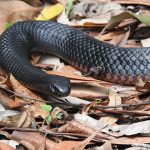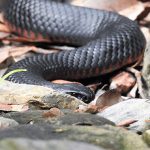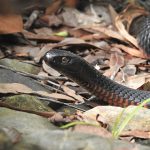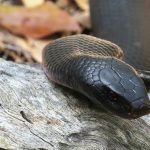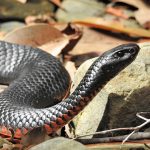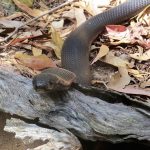RED-BELLIED BLACK SNAKE
Red-bellied Black Snake
In the sun-dappled woodlands and wetlands of eastern Australia, a striking serpent glides through the underbrush. The red-bellied black snake (Pseudechis porphyriacus) is renowned for its glossy black back and vivid red or pink belly, making it one of the most distinctive and widely recognized snakes in the region.
Physical Characteristics
This medium-sized snake typically measures between 1.5 to 2 metres in length, with males often slightly larger than females. Its dorsal surface is a lustrous black, while the lower flanks and belly are adorned with bright crimson to pink hues, creating a vivid contrast. The underside of the tail remains black, and the snout is often pale brown. Juveniles resemble adults but are smaller and may have a more subdued coloration.
Habitat and Distribution
The red-bellied black snake is native to the eastern coast of Australia, from far northern Queensland to southeastern South Australia. It thrives in a variety of habitats, including forests, woodlands, grasslands, and wetlands, particularly near creeks, swamps, and rivers. This adaptability allows it to inhabit both rural and urban areas, often venturing into gardens and parks in search of food.
Behaviour and Diet
Primarily diurnal, the red-bellied black snake is most active during the day, basking in the sun to regulate its body temperature. It feeds mainly on frogs, lizards, and small mammals, but will also consume other snakes, including its own species. In the wild, it has been observed stirring up substrate, possibly to disturb prey.
Venom and Human Interaction
While venomous, the red-bellied black snake’s bite is less toxic than that of some other Australian elapids, and no fatalities have been recorded. Its venom contains neurotoxins, myotoxins, and coagulants, and has haemolytic properties. Victims can also lose their sense of smell. Despite its venomous nature, this species is generally not aggressive and will often retreat when encountered by humans. If provoked, it may strike, but bites are rare.
Reproduction
Mating occurs in spring, with males often engaging in combat to establish dominance and access to females. Females give birth to live young, typically between 5 and 18 offspring, after a gestation period of about 14 weeks. The young are born enclosed in a membranous sac and emerge shortly after birth, measuring around 28 cm in total length.
Conservation Status
The red-bellied black snake is currently listed as a species of “Least Concern” by the International Union for Conservation of Nature (IUCN). However, its populations are threatened by habitat fragmentation and the decline of frog populations, which constitute a significant portion of its diet. Conservation efforts are essential to preserve this species and maintain the ecological balance of its habitats.
The red-bellied black snake is a captivating and integral part of Australia’s natural heritage. Its striking appearance and ecological role highlight the importance of understanding and conserving the diverse wildlife that shares our environment.

